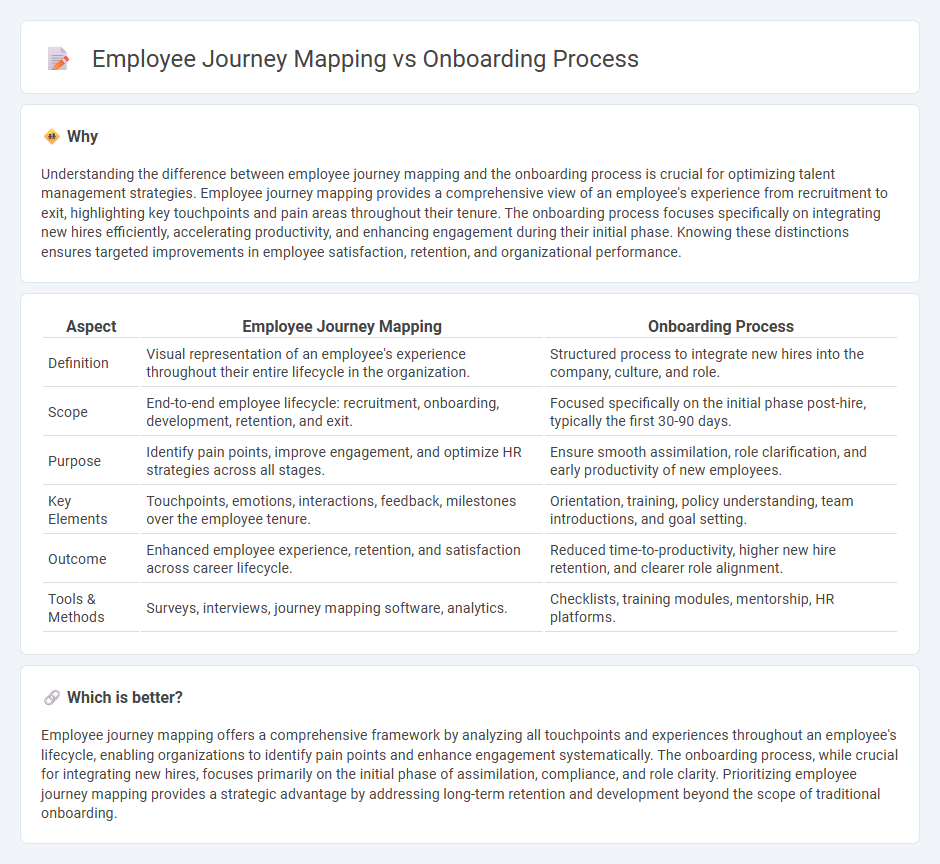
Employee journey mapping provides a comprehensive visualization of an employee's entire experience within an organization, capturing key interactions, emotions, and milestones from recruitment to exit. In contrast, the onboarding process focuses specifically on integrating new hires into their roles, ensuring they have the tools, knowledge, and culture immersion needed for successful productivity. Explore how aligning these strategies can enhance employee engagement and retention.
Why it is important
Understanding the difference between employee journey mapping and the onboarding process is crucial for optimizing talent management strategies. Employee journey mapping provides a comprehensive view of an employee's experience from recruitment to exit, highlighting key touchpoints and pain areas throughout their tenure. The onboarding process focuses specifically on integrating new hires efficiently, accelerating productivity, and enhancing engagement during their initial phase. Knowing these distinctions ensures targeted improvements in employee satisfaction, retention, and organizational performance.
Comparison Table
| Aspect | Employee Journey Mapping | Onboarding Process |
|---|---|---|
| Definition | Visual representation of an employee's experience throughout their entire lifecycle in the organization. | Structured process to integrate new hires into the company, culture, and role. |
| Scope | End-to-end employee lifecycle: recruitment, onboarding, development, retention, and exit. | Focused specifically on the initial phase post-hire, typically the first 30-90 days. |
| Purpose | Identify pain points, improve engagement, and optimize HR strategies across all stages. | Ensure smooth assimilation, role clarification, and early productivity of new employees. |
| Key Elements | Touchpoints, emotions, interactions, feedback, milestones over the employee tenure. | Orientation, training, policy understanding, team introductions, and goal setting. |
| Outcome | Enhanced employee experience, retention, and satisfaction across career lifecycle. | Reduced time-to-productivity, higher new hire retention, and clearer role alignment. |
| Tools & Methods | Surveys, interviews, journey mapping software, analytics. | Checklists, training modules, mentorship, HR platforms. |
Which is better?
Employee journey mapping offers a comprehensive framework by analyzing all touchpoints and experiences throughout an employee's lifecycle, enabling organizations to identify pain points and enhance engagement systematically. The onboarding process, while crucial for integrating new hires, focuses primarily on the initial phase of assimilation, compliance, and role clarity. Prioritizing employee journey mapping provides a strategic advantage by addressing long-term retention and development beyond the scope of traditional onboarding.
Connection
Employee journey mapping identifies key touchpoints and moments that shape an employee's experience from recruitment to exit, enabling HR teams to design a tailored onboarding process that addresses specific needs and expectations. Effective onboarding leverages insights from journey mapping to enhance engagement, accelerate productivity, and reduce early turnover rates. Integrating these approaches results in a cohesive HR strategy that fosters employee retention and satisfaction throughout the employment lifecycle.
Key Terms
**Onboarding Process:**
The onboarding process is a structured introduction phase designed to integrate new employees into an organization by providing essential training, resources, and company culture orientation. Key elements include setting clear expectations, facilitating role-specific skills development, and ensuring compliance with policies to enhance early productivity and retention. Explore how an effective onboarding process can transform new hires into engaged, contributing team members.
Orientation
Onboarding process centers on the initial orientation phase where new hires receive essential company information, role expectations, and culture immersion to accelerate productivity. Employee journey mapping extends beyond orientation by analyzing each touchpoint throughout an employee's tenure, identifying moments that influence engagement, satisfaction, and retention. Explore deeper insights into optimizing both onboarding and ongoing employee experiences for sustained organizational success.
Training
Training in the onboarding process targets new hires with structured learning modules to quickly equip them with essential skills and organizational knowledge. Employee journey mapping views training as a continuous touchpoint, identifying development opportunities throughout an employee's career to enhance performance and satisfaction. Discover how integrating these approaches can maximize training effectiveness and employee engagement.
Source and External Links
Complete Employee Onboarding Guide - This guide provides an overview of the onboarding process, including key components and innovative approaches to help new employees integrate into an organization effectively.
Employee Onboarding Process: A Complete Guide - This guide outlines a step-by-step approach to employee onboarding, from releasing the offer to the day of joining, emphasizing a structured process to engage new hires.
What Is Employee Onboarding? A Complete Guide - This guide details the stages of employee onboarding, including preboarding, orientation, and beyond, highlighting best practices for a successful onboarding experience.
 dowidth.com
dowidth.com